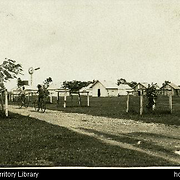
Kahlin Compound, May 1930, courtesy of Northern Territory Library.
Details
The Kahlin Compound was established in Darwin in 1913 as a reserve in which to segregate and control Aboriginal people. Initially 76 people lived within the Compound but numbers soon grew. Children living in the Compound slept in separate dormitories. Kahlin Compound closed in 1939 after all residents were moved to the new Bagot Aboriginal Reserve in 1938.
The Kahlin Compound was established in Darwin in 1913 as a means of segregating Aboriginal people from the rest of the population of the town and controlling their lives. The policy of segregating Aboriginal people, particularly those referred to at the time as 'half-caste', developed as a result of the investigations and recommendations of Professor Baldwin Spencer who was appointed Chief Protector in 1911.
Section 13 of the Northern Territory Aboriginals Act 1910 provided the Governor with the legal right to establish such a compound. This Act was passed by the South Australian Government just before the Northern Territory came under Commonwealth control. These same powers were continued and extended in the Northern Territory Aboriginals Ordinances of 1911 and 1918 which were passed after the Territory came under Commonwealth control.
As a result of Spencer's policy recommendations, accommodation for Aboriginal people in Kahlin compound was erected during 1913. The layout was described by the Chief Protector in the Annual Report of that year:
There are now sixteen bark huts, a boys' dormitory, girls' dormitory, kitchen, laundry, office, storeroom, coach-house and fodder room, a fowl house, and some old dilapidated buildings in the gardens. We have now nearly completed a large dormitory for the girls. The dimensions are: - Length, 40 feet; width, 20 feet; walls, 10 feet; material, galvanized iron walls and roof, concrete floor. This will accommodate twenty beds. The building is well ventilated.
At that time 76 Aboriginal people, including men, women and children lived within the compound. A fence of wooden posts and barbed wire surrounded the 13 acre area. A one-teacher school was opened in November 1913 and a permanent superintendent and matron took over control in 1915.
Rules and discipline in the school and the Compound were very strict. Val McGuiness who lived in the Compound as a boy in 1918 remembers a difference in the way boys and girls were treated:
The boys were quite free as far as the reserve was concerned but the girls had to be locked up in dormitories like birds in a cage. They had to be taken in by six o'clock and we would go to the window, you know, and talk to the girls. But they never locked us up.
A 1923 Commonwealth parliamentary inquiry into Aboriginal issues in Northern Australia headed by Senator Newland, included an investigation of conditions at the Kahlin Compound. Conditions in the Compound were criticised and Newland recommended that it be closed and moved to a site further from the town. However, as the Compound provided a source of cheap labour for the white residents of Darwin, it remained open.
A subsequent inquiry into the Compound appointed by the NT Administrator also recommended that a new compound be established and that 'half-caste' children should be separated from adults. It advocated that the children be placed in a separate institution where they could be disciplined and trained to 'take their place' in the community. This policy led to the opening of the Half-Caste Home at Myilly Point in 1924 and the removal of the majority of children from Kahlin.
The Kahlin Compound continued to operate through the 1920s and 1930s. Conditions in the Compound were often severely criticised. In early 1937 a cyclone caused damage to many of the buildings and living conditions deteriorated further.
In April 1937 an alternative site for an Aboriginal Reserve was purchased by the government. This area became known as the Bagot Aboriginal Reserve. All residents of the Kahlin Compound were moved to the new reserve during 1938 except for the residents of the Myilly Point Home. The Kahlin Compound closed in 1939 and was revoked as an Aboriginal Reserve on 3 July 1940.
Kahlin Compound was mentioned in the Bringing Them Home Report (1997) as an institution that housed Indigenous children removed from their families.
Sources used to compile this entry: Austin, Tony, I can picture the old home so clearly: The Commonwealth and 'Half-caste' Youth in the Northern Territory 1911-1939, Aboriginal Studies Press, Canberra, 1993, 280 pp; Cummings, Barbara, Take this child: From Kahlin Compound to the Retta Dixon Children's Home, Aboriginal Studies Press, Canberra, 1990, 139 pp; Human Rights and Equal Opportunity Commission, Bringing Them Home: Report of the National Inquiry into the Separation of Aboriginal and Torres Strait Islander Children from Their Families, Commonwealth of Australia, 1997, https://www.humanrights.gov.au/sites/default/files/content/pdf/social_justice/bringing_them_home_report.pdf. Kahlin Compound was mentioned in the Bringing Them Home Report (1997) as an institution that housed Indigenous children removed from their families.; NAA: F1, 1938/366 Kahlin Compound. Aboriginal Compound & Half-caste Home 1933-1938.
Prepared by: Karen George and Gary George
Created: 8 February 2011, Last modified: 7 November 2018